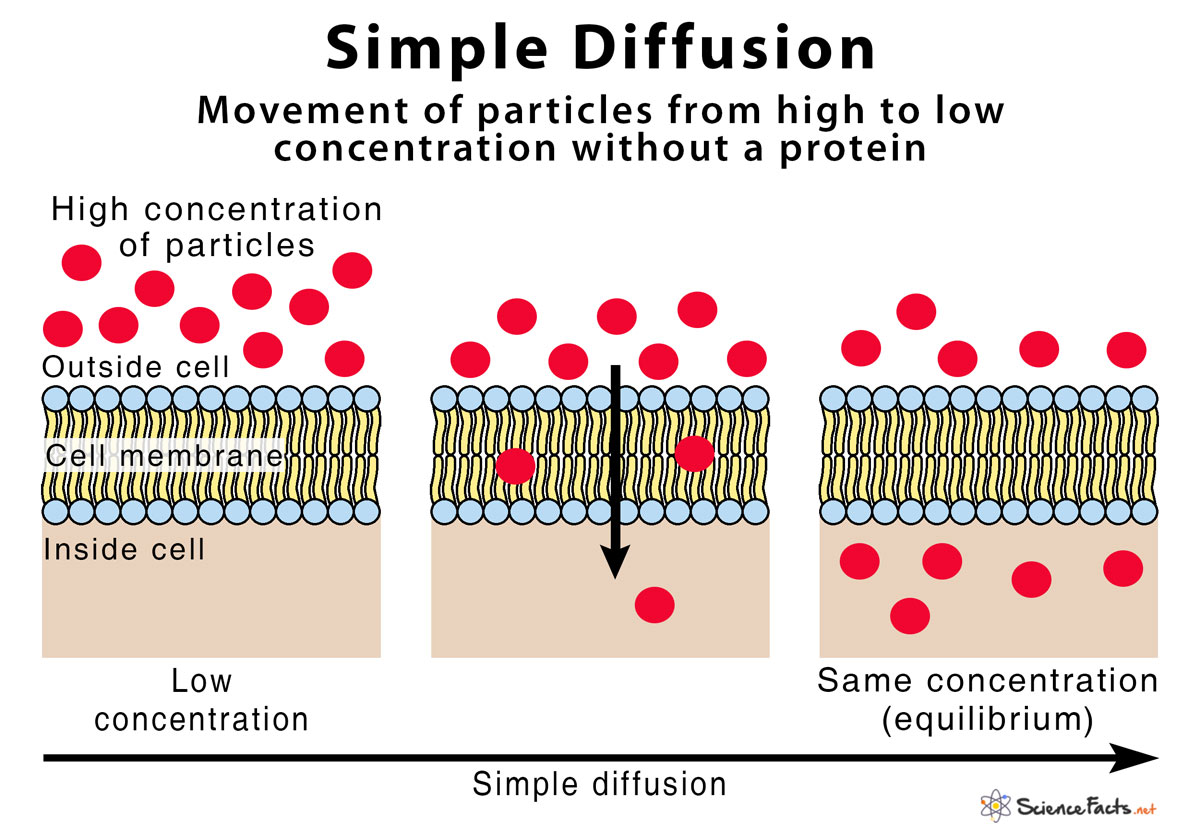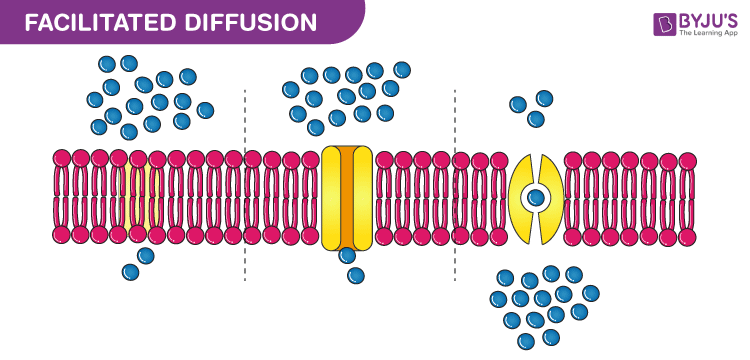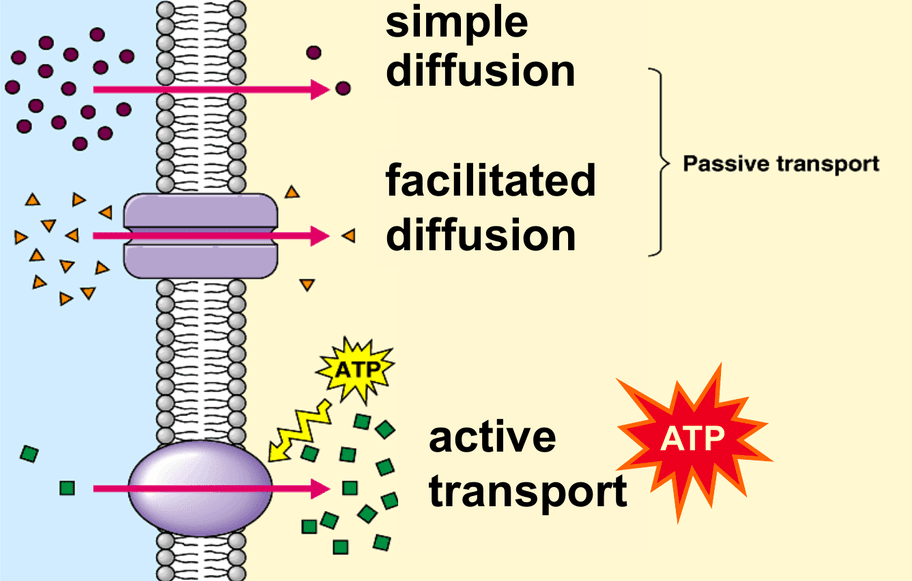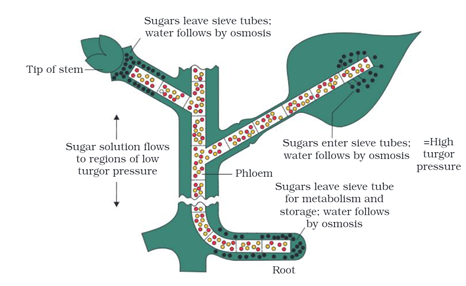Transport in Plants Study Guide
Introduction
How does water reach the top of a tall tree from the root? Through a process called transportation! Transportation in plants is conducted through tissues that carry water, nutrients, and minerals throughout their body system. Transportation of these nutrients over short distances occurs through diffusion and is commonly seen in flowering plants. Long-distance transfer of nutrients via the vascular system (xylem and phloem) is known as translocation and is commonly observed in the cases of tall trees. Translocation can be unidirectional, as in the case of water from the roots to the stems, or multidirectional, as in the case of minerals and organic solutes. We’ll cover all of these topics in this study guide starting with diffusion.
Diffusion
Diffusion is the movement of molecules from an area of high concentration to an area of low concentration. It is a slow process and does not require energy to occur. The rate of diffusion is determined by four variables: concentration gradient, membrane permeability, temperature, and pressure.
Diffusion of substances majorly depends on its solubility in lipids (lipids are a major membrane component). As expected, lipid solubility is an important factor for substances to pass through the cell membrane, and is the dividing factor between the two types of diffusion: simple and facilitated. Let’s talk about these processes a little more below.
Simple Diffusion
Simple diffusion is a passive process that works as described above where molecules move from high concentrations to low concentrations. This type of diffusion differs from facilitated diffusion because the molecules are lipid soluble and thus able to pass through a cell’s lipid bilayer passively and without assistance from other molecules.

Facilitated Diffusion
Facilitated diffusion is a passive form of transport like simple diffusion is, but in this case the molecules are not lipid-soluble and require protein channels called aquaporins to pass through the cell membrane. Aquaporins allow water-soluble compounds to be transported without the need for energy. The protein creates channels in the membrane through which chemicals can travel.
Some carrier proteins allow diffusion of molecules only in pairs. Let’s briefly define the different types of this mechanism of transport below:
-
Symport: Both molecules cross the membrane in the same way
-
Antiport: Both molecules travel in the opposing direction
-
Uniport: Occurs when a molecule passes across a membrane without the help of other molecules.

Active Transport
All molecules cannot pass through the cell membrane as they do with simple and facilitated diffusion. Let’s briefly talk about the other form of transport: active transport.
-
Active transport pumps molecules against a concentration gradient using energy. Membrane proteins are responsible for this.
-
Pumps are mobile carrier proteins that are used in active transport.
-
Pumps are capable of transporting substances from low to high concentrations. What the carrier proteins carry across the membrane is quite specialized.
See how active transport differs from simple diffusion and facilitated diffusion in the image below. Take note of the concentration gradients between the inside and the outside of the cell in each method of transportation.

Plant-Water Relations
There are three ways water moves through plant cells: osmosis, plasmolysis, and imbibition. Let’s start with osmosis.
-
Osmosis is the transport of molecules through a semipermeable membrane from a greater concentration location to a lower concentration region until equilibrium is attained. The plant cell wall allows chemicals in water to pass easily. There are two forms of osmosis: endosmosis and exosmosis.
- Endosmosis is the transport of water molecules into the cell. This occurs when a cell is put in a hypotonic solution (a solution with a lower concentration of soutes). Exosmosis is the migration of water molecules out of the cell. This process occurs when a cell is put in a hypertonic solution (a solution with a higher concentration of solutes).
-
Plasmolysis is when water leaves a cell, causing the cell membrane to shrink away from the cell wall. This process occurs when a cell (or tissue) is put in a solution that is more hypertonic than the protoplasm. Water escapes the cell, first from the cytoplasm, then from the central vacuole.
-
Imbibition occurs when water is absorbed by solids and causes them to expand. Examples include water absorption by seeds and dry wood. This process is technically classified as a type of diffusion since a water potential gradient is essential between the absorbent and the liquid.
Water Movement in Plants
The main tissue responsible for water transport in plants is the Xylem. A mass or bulk flow system generally moves water, minerals, and food. When ions in the soil are actively carried into the vascular tissues of the roots, positive pressure is created inside the roots, causing transpiration pull to occurs.
-
This results in positive pressure inside the roots called root pressure that is responsible for upward water migration.
-
At night, the effect of root pressure may be visible in droplets of water on the leaves of a plant. When the rate of evaporation is low, excess water is released from the tips of the leaves in an occurance called Guttation.
Transpiration pull is the force that propels water upward. During transpiration, water is lost, resulting in negative pressure in the xylem vessels. This negative pressure is what causes transpirational pull to occur.
Dixon and Jolly presented the Cohesion-Tension Theory to explain the upward flow of water in plants. Cohesion is the term for the attraction between water molecules, and adhesion is the term for attracting water molecules to other polar molecules. Another feature that boosts transpiration pull is surface tension. Surface tension refers to the attraction between water molecules in the liquid phase.
Mineral Transport in Plants
Mineral transport in plants occurs in two ways: actively and passively. Because ions are charged and cannot pass the membrane without burning energy, the bulk of transport happens actively.
During active mineral transport, energy is provided through ATP. Sucrose, a photosynthetic end product, is transferred from the source (where synthesis takes place, such as leaves) to the sink (organs that store food). Water transfer is unidirectional, but food or sugar transmission is bidirectional.
Translocation
The main tissue responsible for food transport/translocation in higher plants is the phloem. The Pressure-Flow Theory (also known as the mass flow hypothesis or Munch hypothesis) was developed for sugar translocation from source to sink.
Phloem comprises sieve tubes, companion cells, and phloem parenchyma. Food is actively transported from source to sink via sieve tubes and companion cells. Sugars are put into a sieve tube passing through the phloem, starting at the source. The hypertonic environment created by loading sieve tubes allows water to reach the phloem. The food/sucrose goes towards the sink, which has low osmotic pressure, due to the strong osmotic pressure at the source. As a result, osmotic pressure is thought to be the driving force behind food migration from the source to the sink.

✅ Conclusion
-
Plants carry a variety of chemicals such as gases, minerals, water, hormones, and organic solutes over short distances (from one cell to another) and long distances (from roots to tips of the stem) as water.
-
There are two ways that molecules diffuse into or out of cells: simple diffusion and facilitated diffusion. Both of these methods move from areas of high concentration to areas of low concentration and occur passively.
-
Active transport is the process of moving molecules into or out of a cell from a low concentration to a high concentration. This occures actively and requires energy to complete.
-
Water moves throughout the cell via osmosis, plasmolysis, and imbibition.
-
Translocation by mass flow refers to long-distance transfer via the vascular system, xylem, and phloem. Translocation can be unidirectional, as in the case of water, or multidirectional, as in the case of minerals and organic solutes.
FAQs
1. Why is plant transport important?
Plant transportation is required to circulate water, critical nutrients, excretory products, and gases inside the plants for a variety of reasons.
2. What affects in transportation in plants?
Water, nutrients, and photosynthates are transported throughout the plant thanks to the structure of plant roots, stems, and leaves. How water and nutrients are carried in plants is influenced by water potential, evapotranspiration, and stomatal control.
3. What is translocation?
Translocation refers to the movement of food in plants. It is carried out with the aid of phloem, a conducting tissue.
5. How does translocation occur in plants?
Translocation occurs when water pressure builds as it enters the plant, forcing water and dissolved elements to travel upward via the phloem from the leaves to the remainder of the plant, where they can be stored or converted into energy.
4. What is the function of the xylem and phloem?
Xylem transports water and mineral salts from the roots to various regions of the plant. Phloem tissue is responsible for food transport/translocation in higher plants.
We hope you enjoyed studying this lesson and learned something cool about Transport in Plants! Join our Discord community to get any questions you may have answered and to engage with other students just like you! Don’t forget to download our App to experience our fun, VR classrooms – we promise, it makes studying much more fun! 😎
Sources
-
Transport in Plants. https://ncert.nic.in/textbook.php?kebo1=11-22. Accessed 20 Dec, 2021.
-
Transportation In Plants. https://byjus.com/biology/transportation-in-plants/ Accessed 20 Dec, 2021.
-
Transport in Plants. https://untamedscience.com/biology/plants/transport-in-plants/ Accessed 20 Dec, 2021.
